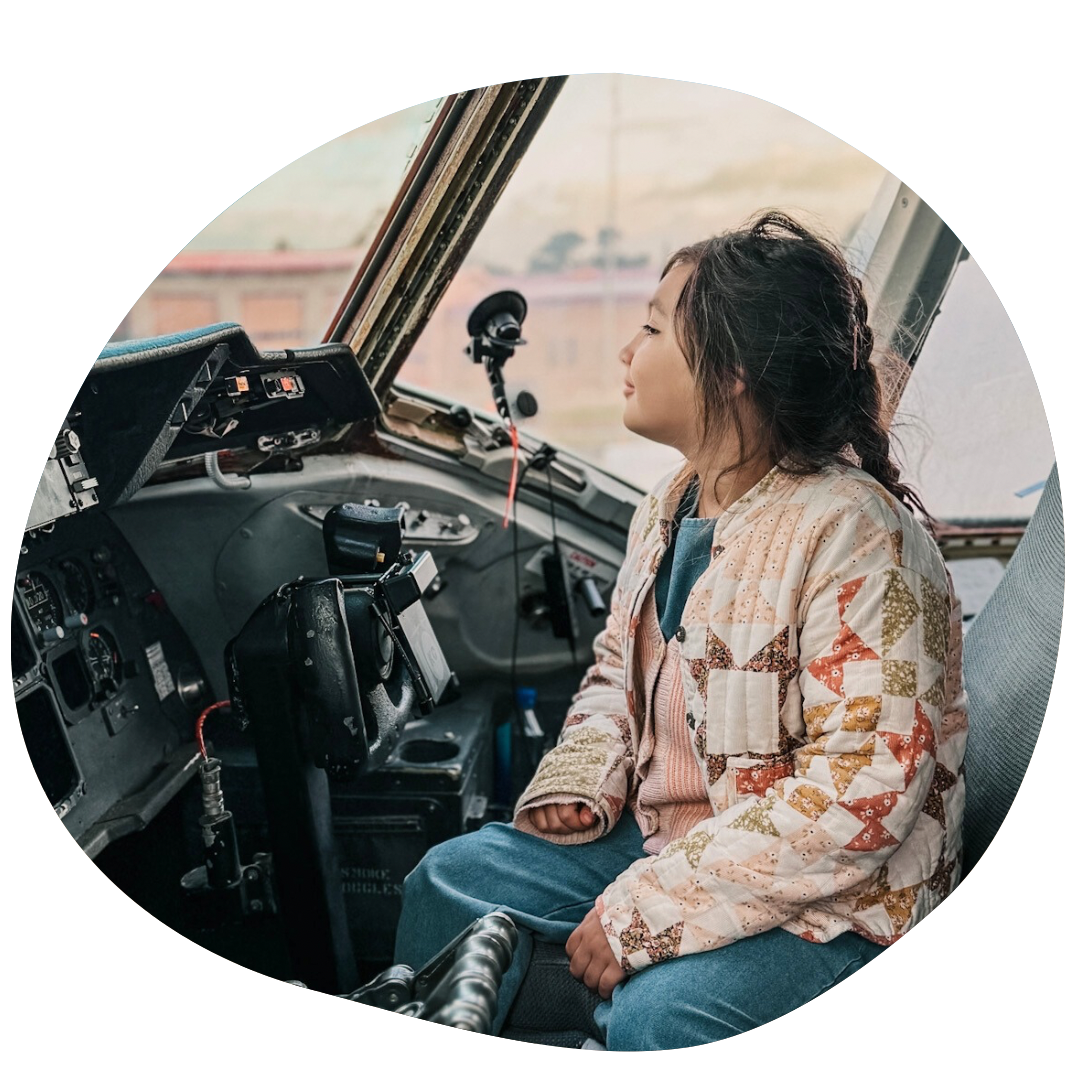
Tips For Flying Space-A With Kids From Our Family
Thinking about flying Space-A with kids? We’ve been doing it since 2017. It’s challenging, rewarding, and one of the best ways we’ve traveled as a family. Here’s why we think it’s totally worth it, plus tips from a full-time travel family who’s lived it.
saltyvagabonds
Destinations
Travel Tips
Planning
About us
Saltyvagabonds
Amanda has been flying Space-A with the kids since 2017. She’s been through it all, flying solo with a baby, navigating the toddler stage, and now traveling with older kids who have their own DoD IDs. Let us share some tips to make your journey smoother, easier, and way more enjoyable.
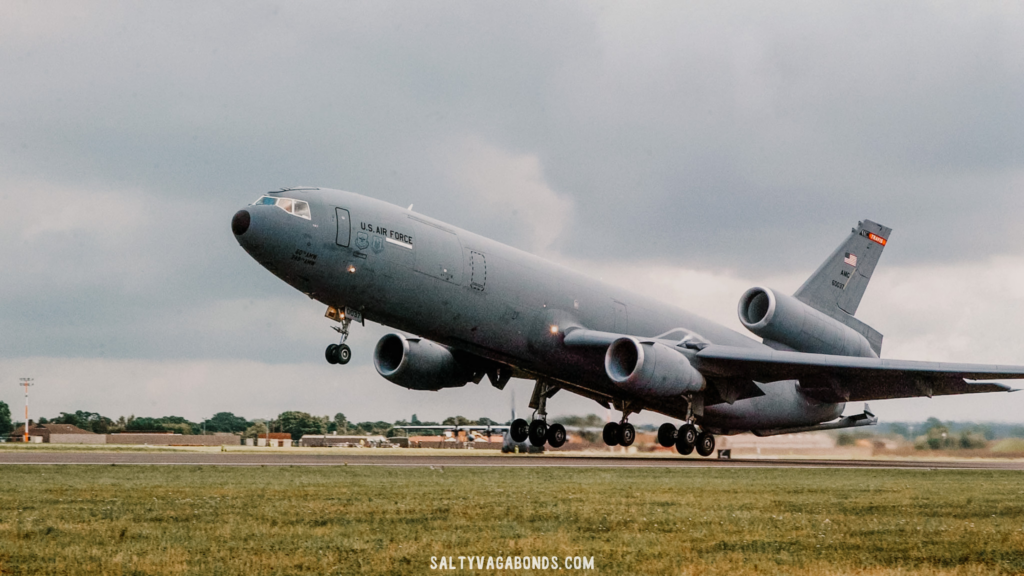
All of Your Children Need Proper Identification
The rules have changed slightly with the 2025 update, so don’t get caught off guard. Our post Flying Flying Space-A with Kids: New ID Rules Parents Need to Know is your go-to guide for the latest info.
To break it down simply:
- Everyone, including young children and babies needs a form of identification.
- Kids 10 and older can now get a DoD ID.
- Kids under 10 will need an ID issued by a federal, state, or local government authority (like a passport or state ID).
This is one of the most important things to prep before your Space-A journey.
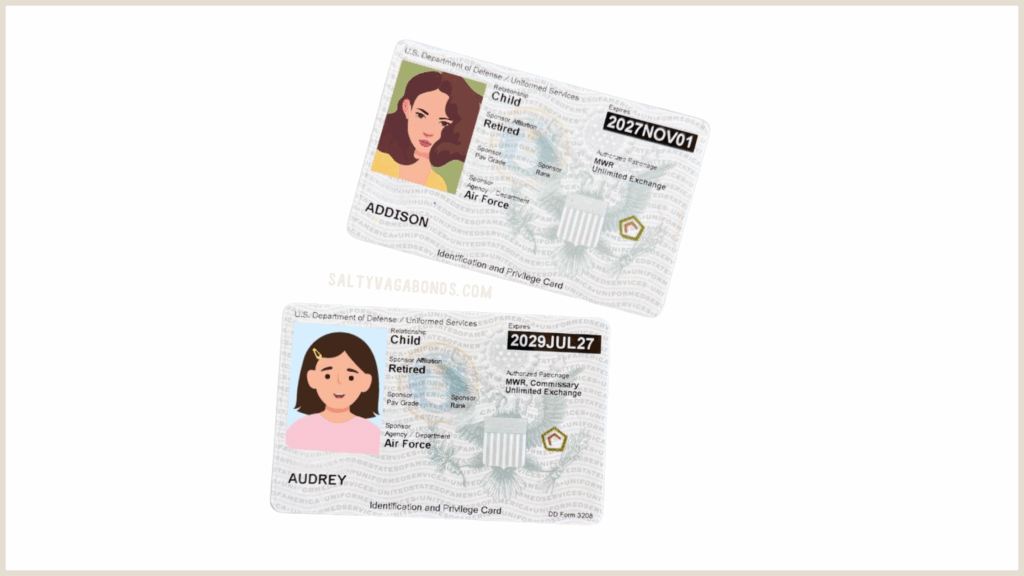
Check as Much Luggage as You Can—Including Car Seats, Strollers, and Pack ’n Plays
Let’s be real, Space-A is a full-on adventure nearly every time we fly. Because of that, we always check as much luggage and gear as we possibly can, including car seats, strollers, and pack and plays.
Why? Because getting on and off these flights isn’t like boarding a commercial airline with a jetway. You’ll likely be walking across the tarmac, hopping into a van or bus, and then climbing stairs to enter the aircraft.
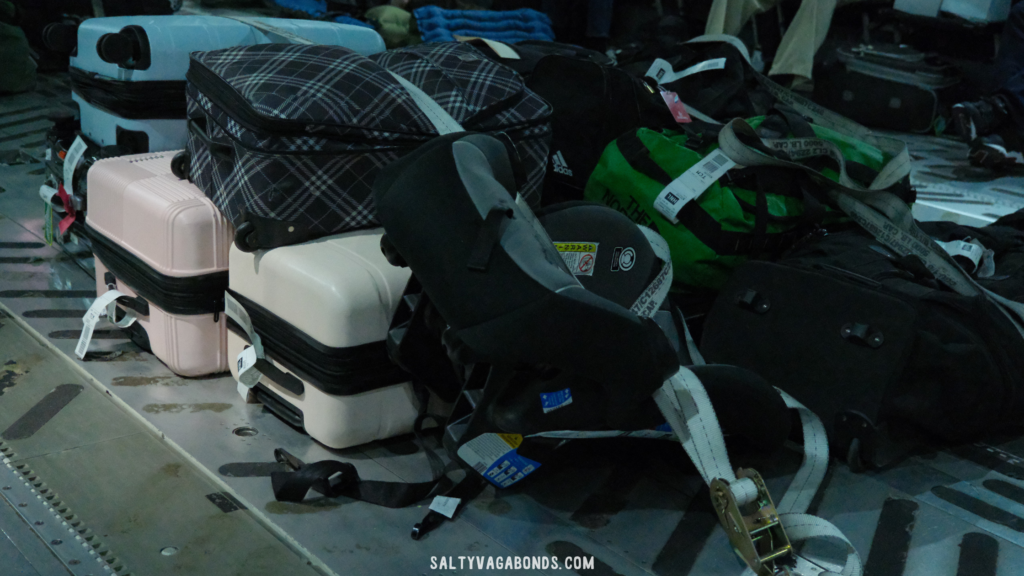
If you’re flying on a C-5, for example, you’ll need to climb a two-story staircase or sometimes a ladder to get to the seating area upstairs. And many other military aircraft are designed similarly, with stairs or ladders to reach the seating area.
That’s why it’s best to travel light in-hand and wear a backpack, so your hands are free, especially if you’re flying with small children who may need help up the stairs or ladder.
All Kids and Parents Must Have the Right Clothing
Flying Space-A is an amazing benefit, but there are a few non-negotiable rules, especially when it comes to what you wear. The one they harp on the most? You must be wearing closed-toe shoes with a heel. Think boots, sneakers, or loafers.
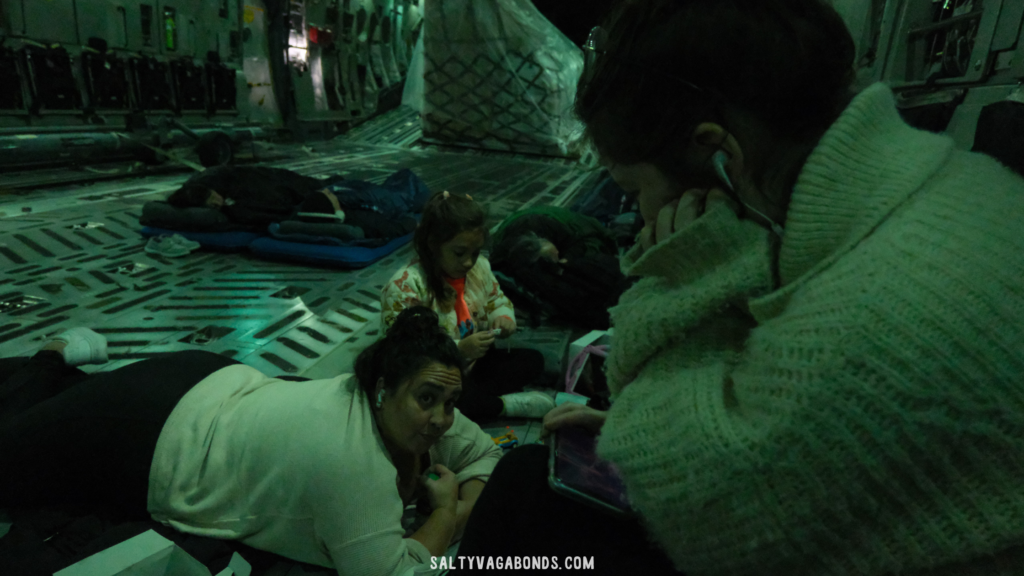
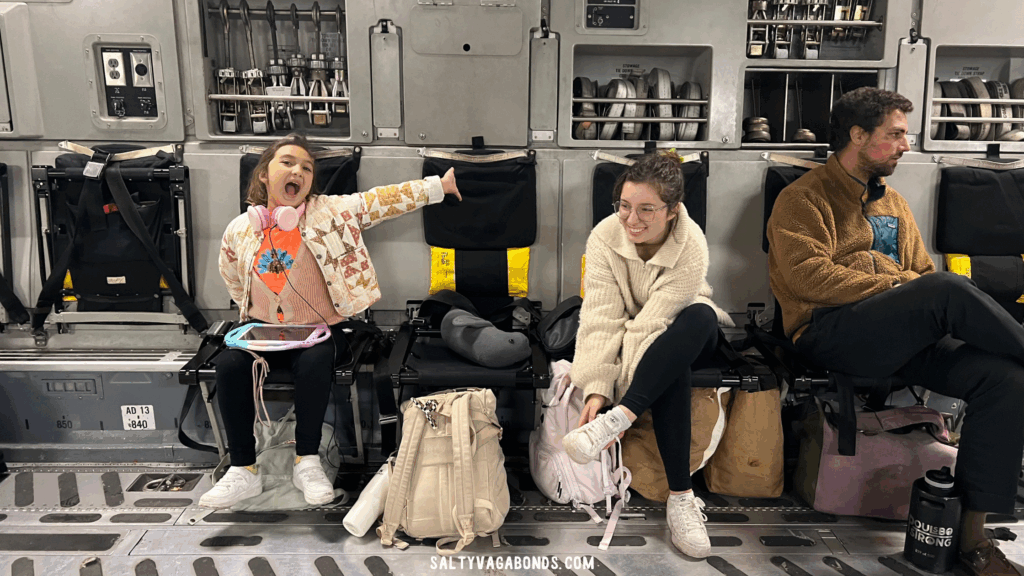
Flip-flops, sandals, and Crocs are not allowed, and yes, they will turn you away at the terminal if you or your kids aren’t wearing proper footwear. So make sure everyone is dressed appropriately before you head to roll call.
You’ll also want to wear or pack warm layers in your carry-on. These aircraft can get cold, especially on longer flights. I recommend wool socks and wool base layers for great temperature control.
And if it gets really chilly, you can always ask the loadmaster to turn on the heat. Fun fact: the cabin air gets warm from compression, and they don’t always cool it down before it enters, so yes, heat is possible, and it works!
Every Person Must Have Their Own Seat on the Aircraft
When flying Space-A, every single passenger must have a seat, even babies and young kids. That means when you sign up, you need to include everyone who will be flying, whether it’s a newborn or your spouse.
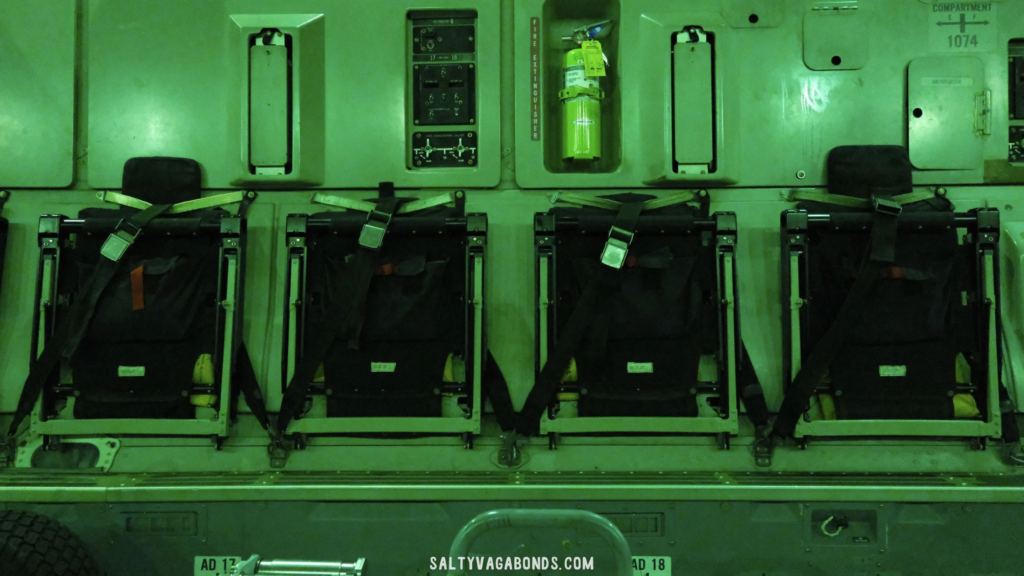
I always recommend securing your child’s car seat (the kind that clicks into a stroller base) to the aircraft seat using the seatbelt. Turbulence can hit hard and without warning, and trust me, as a pilot, even we get surprised sometimes.
Keeping everything secured helps prevent injuries and makes the whole experience much smoother and provides a safe place for you and your little ones.
Bring Extra Infant Formula, Breast Milk, Juice, and Water
Kids love what they love, and drinks are no exception. Air Mobility Command (AMC) follows the same liquid guidelines as TSA, so here’s the deal:
You can bring liquids like infant formula, breast milk, or juice in containers that are 3.4 ounces (100 ml) or less, packed inside a quart-sized zip-top bag. You can have multiple 3.4 oz containers in that one bag.
That said, most AMC terminals have vending machines after security. So if you forgot your water bottle or want to grab an iced coffee, don’t stress. Especially in Japan, the vending machines are clutch and usually stocked with solid options.
Child-Specific Ear Protection
We travel a lot, to say the least, and ear protection (or “ear pro”) is a must, especially on military aircraft. As a pilot, it’s something older pilots always talk about: the high-pitched whine from jet engines can do real damage over time. Protecting your ears, and your kids’, isn’t optional. It’s essential, especially on long-haul flights where that noise exposure adds up fast.
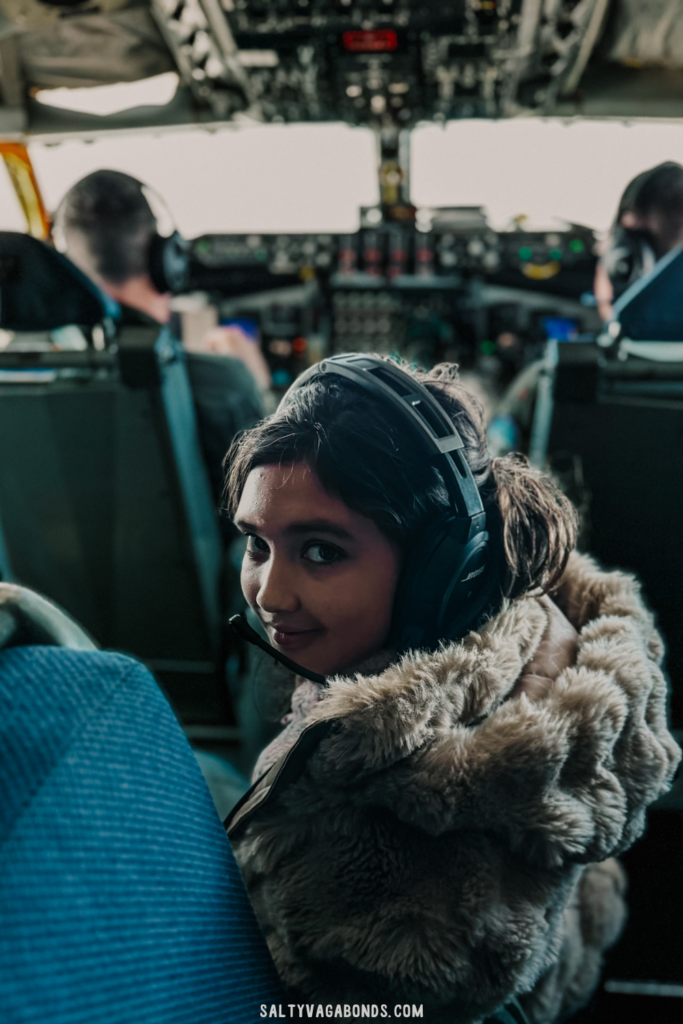
For babies, there are headband-style baby muffs made specifically for tiny ears. Toddlers and older children can use standard noise-reducing muffs or noise-canceling headphones. We personally use noise-canceling headphones, but ear plugs or noise-dampening muffs also work well.
If you forgot your baby’s or toddler’s ear pro, don’t panic. You can ask one of the crew members for a foam earplug and see if they’ll cut it in half to make it fit.
Another backup option? Tissue paper or cotton balls. It’s not ideal, but it can reduce noise levels by around 7 decibels, and that’s definitely better than nothing.
Bring Electronics & Activities
We catch a lot of flights every year, and sometimes waiting in the terminal is just as boring as the flight itself. One of the best things you can pack? Electronics and simple activities to keep everyone entertained.
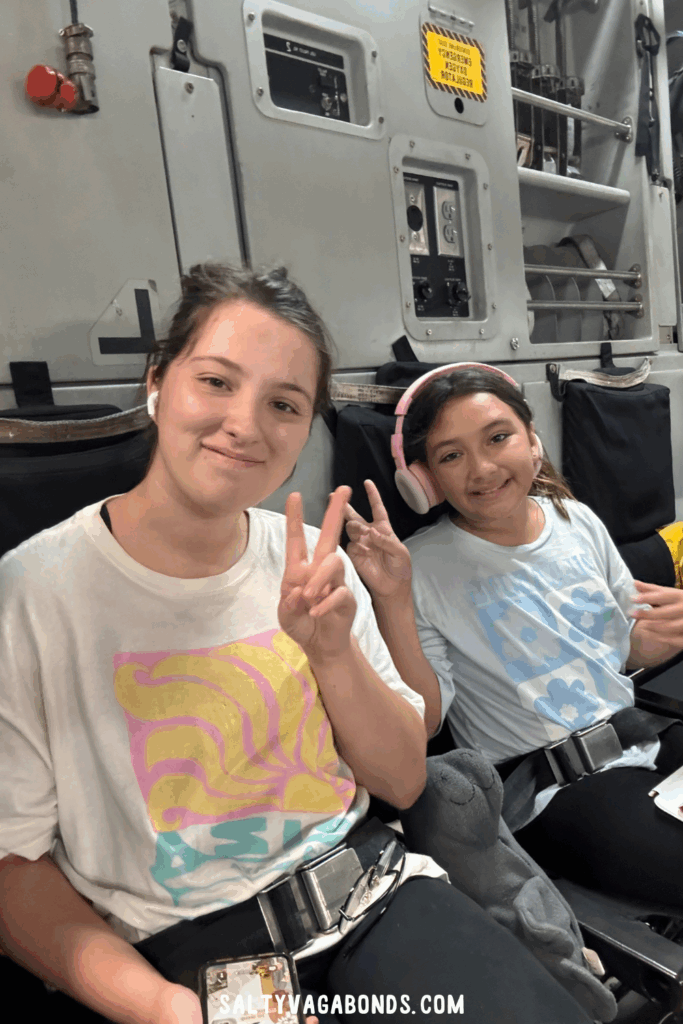
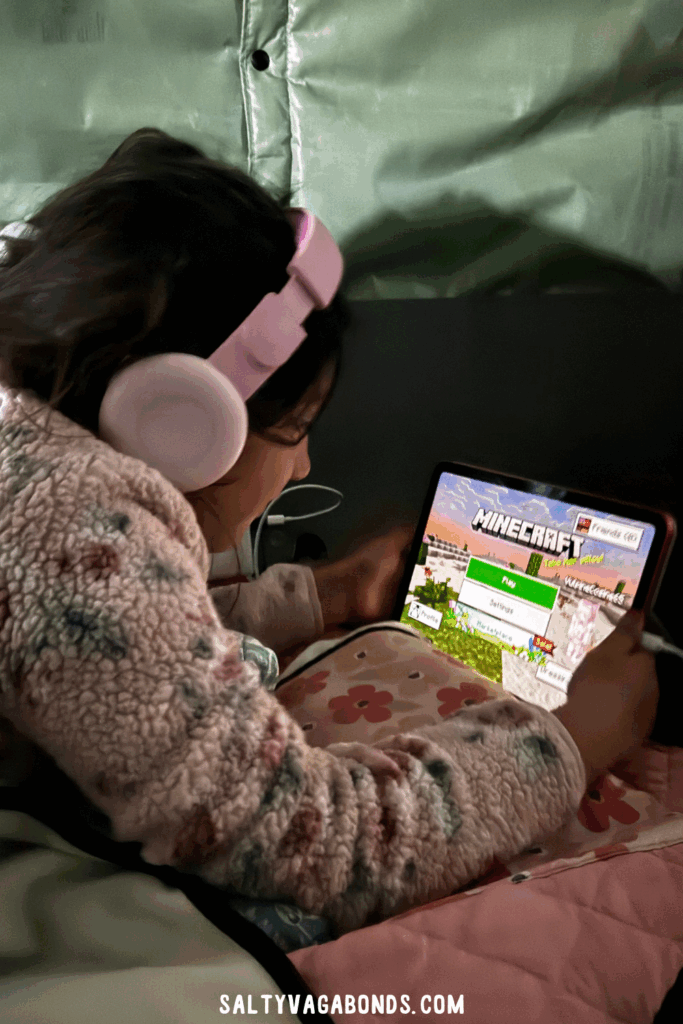
For us, that means iPads, phones, and anything that holds a charge. A fully loaded child’s device is gold, but if it’s not fully charged, no worries. A few battery banks can save the day.
We also always bring card games like Uno or a regular deck of playing cards. They’re perfect for passing the time, making new friends, or surviving the military’s classic “hurry up and wait” vibe.
And honestly, with kids, almost anything can turn into a game, from hide and seek in an empty terminal corner to silly drawing challenges. Just be ready to pivot and play.
Meals and a Huge Snack Bag
Food is always a hot topic with our crew. Traveling Space-A can be unpredictable, especially with midnight roll calls or those brutally early flights. That’s why we always order meals (box nasties) when we can, and I highly recommend ordering one extra meal beyond your party size. It’s great to have an extra portion of fresh fruit or something substantial in case plans shift (which, let’s be honest, happens a lot).
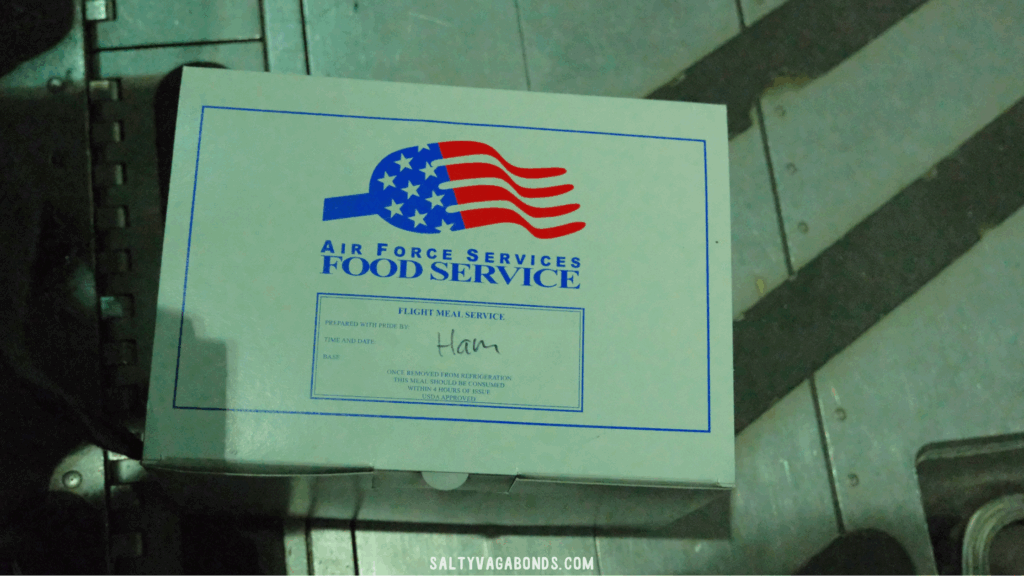
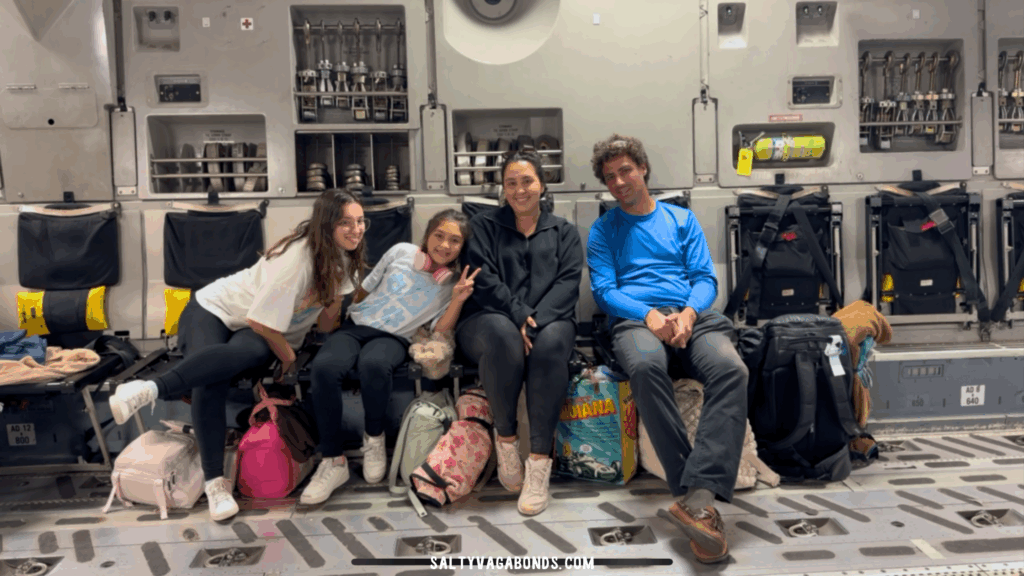
As for snacks, don’t hold back. We travel with a giant Trader Joe’s grocery tote packed to the brim. It’s kind of like our on-the-go parent menu, and it saves us every time. Here’s what we usually bring:
- Protein-packed snacks to keep everyone full:
We love options from Bavarian Meats, Kaimana Tuna Jerky, and EPIC Provisions (their bison, chicken, deer, and pork options are amazing). - Dried fruit:
Mango is the household favorite, but we’ll take it in any form. - Cheese-based snacks:
Parmesan crisps, Cheese-Its, or anything crunchy and salty. - Trail mix:
A combo of nuts, raisins, dried cranberries, and a little chocolate or sweetness to keep spirits high.
Basically, pack like you’re prepping for a road trip with wild cards, because Space-A doesn’t always go as planned. A solid snack stash can absolutely make or break your day. And whatever you do, don’t pack jelly for those PB&J sandwiches, TSA has confiscated it from us way too many times. Instead, bring disposable cutlery (those plastic ones from takeout work great) or a MRE spoon for eating or spreading. Trust me, you’ll be glad you did.
U.S. Military Aircraft Are Not a Playground
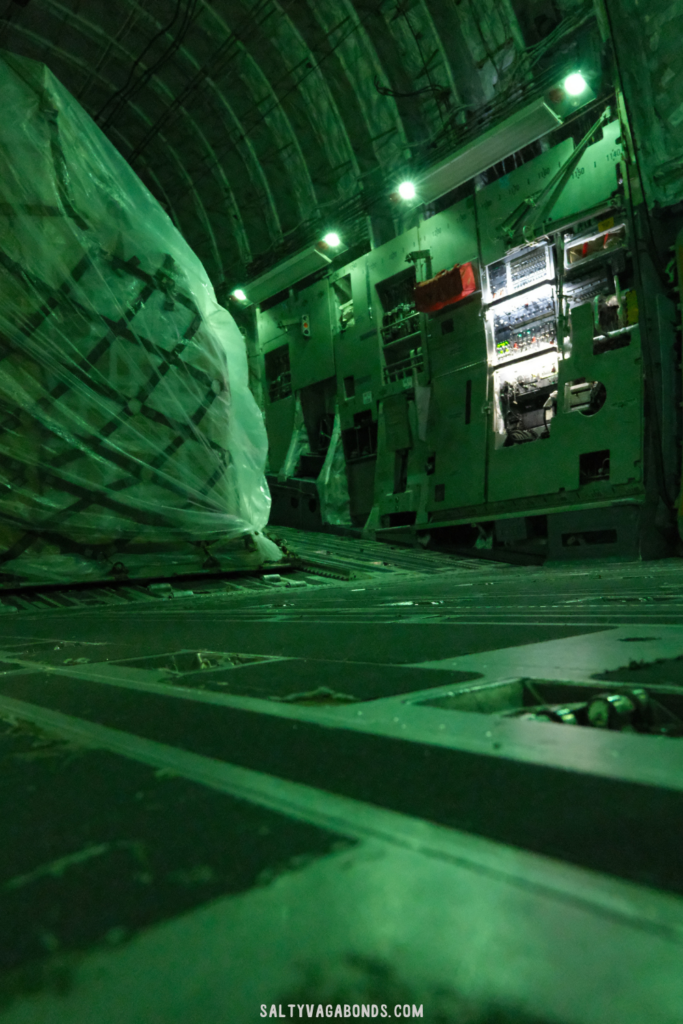
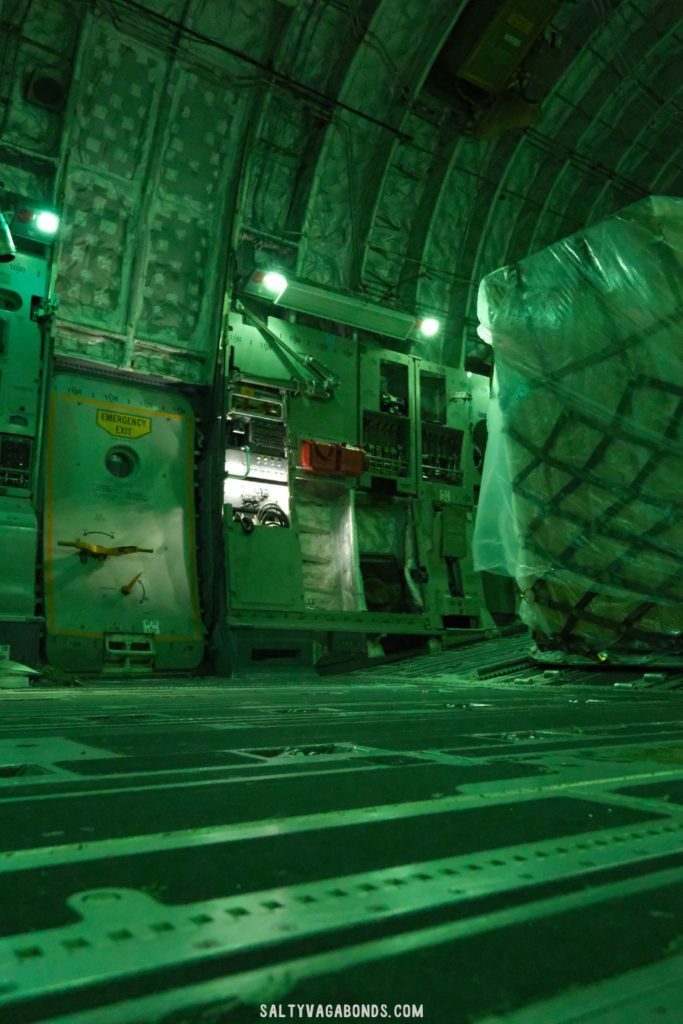
We haven’t personally seen kids running wild during a Space-A flight, but we’ve definitely heard the stories. Military aircraft are big, open, and unlike anything most families are used to.
So yes, it’s tempting for young children to see it as a giant play space. But let’s be clear: these planes are not child-proof or safe for rough play. There are trip hazards everywhere, especially when cargo is on board.
Kids can and should get up and move around to burn off some energy, but it needs to be done safely and respectfully. This isn’t the place for tossing a football or running laps. And it’s not just about the kids, adults also need to be mindful. Don’t camp out in someone else’s space or block walkways, especially in front of another family’s designated area.
And parents? If your child is awake, you need to be awake. You’re used to your child’s behavior, but others aren’t. Stay engaged, stay alert, and help set the tone for a respectful flight environment for everyone.
Sleep Setup and Gear
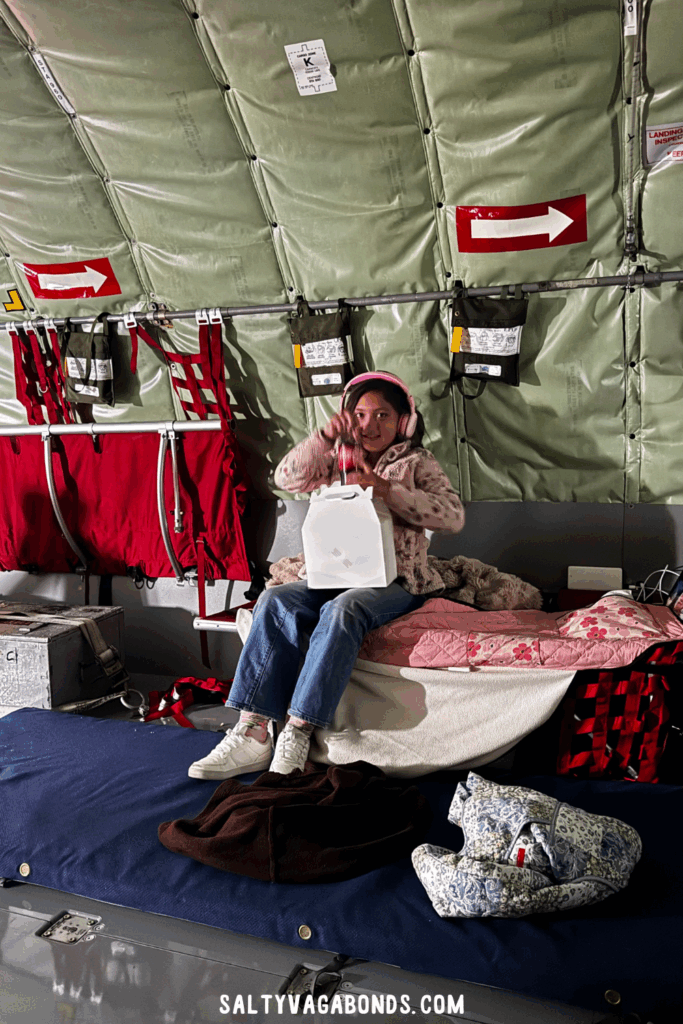
A lot of families bring full-on sleep setups for Space-A flights, and honestly, why not? As long as it’s safe, the crew will usually let you lay on the floor. We’ve seen people with everything from sleeping gear like inflatable mats and sleeping bags to full rollouts that zip together for a big shared sleep space.
We keep things a little lighter. Audrey carries an urban kid sleep roll, it has a built-in pillow and doubles as a blanket. I pack two towels to throw on the floor to stay off the cold aluminum, and we always wear warm layers: jackets, wool socks, and long pants are non-negotiables.
We don’t bring a full mat for each person because we usually sleep at different times than other crew members on our team. Plus, we like to save space for other essentials like camera gear, snorkel kits, and everyday travel stuff. The way we see it, the discomfort of Space-A is temporary, but hauling too much stuff is a pain the whole trip.
That’s just our take on sleeping gear, but you’ll figure out what works best for your family after a few flights and what you can’t live without.
Backpacks and Carry-Ons with a Carabiner
We once watched a family of seven board with multiple roller bags, a stroller, and a mountain of carry-ons. Honestly? It’s not necessary, and it just makes the boarding process harder. When flying Space-A, check as much as you can. You won’t lose your checked luggage, and oftentimes, you’ll see the crew strap it down securely once you’re on board.
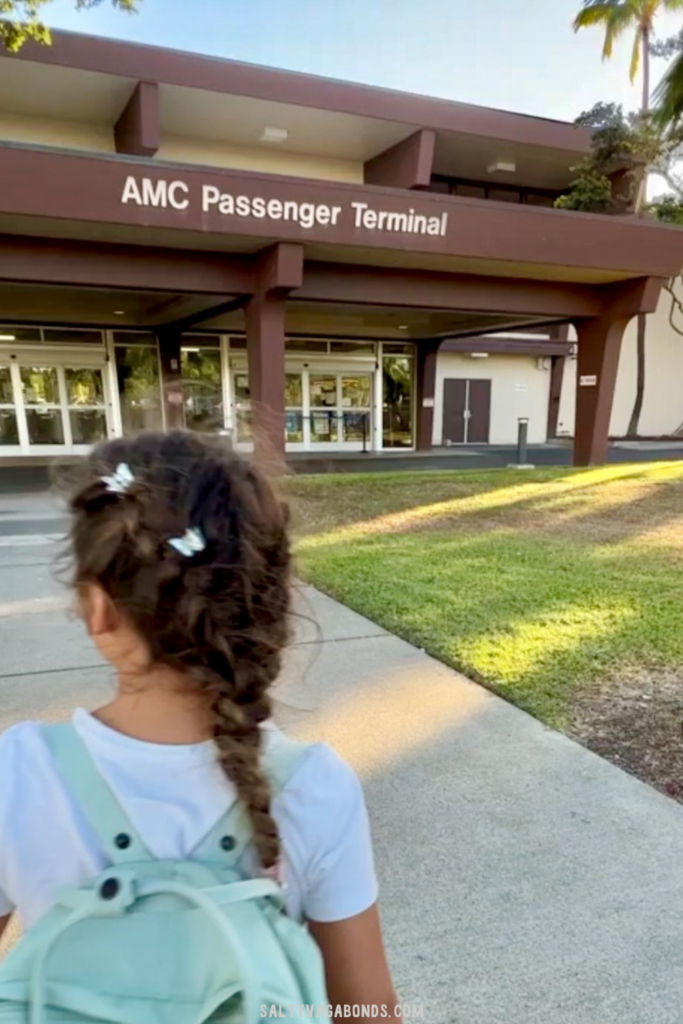
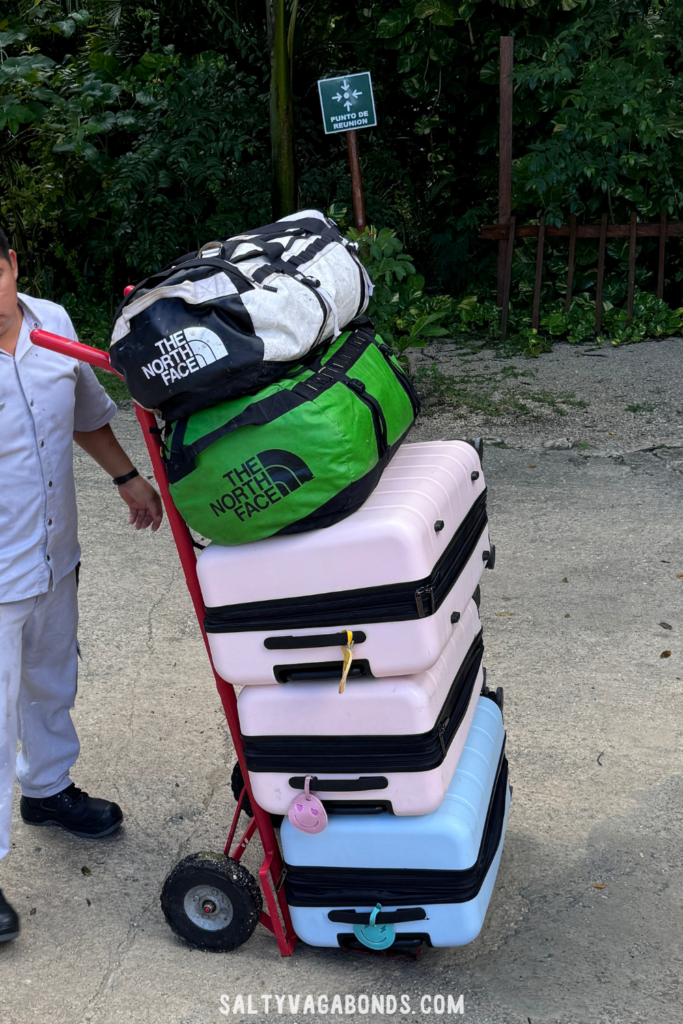
What we do recommend bringing in-hand is a good backpack, especially one that’s easy to manage in tight spaces. And here’s the real MVP: a heavy-duty carabiner. You’ll want one on hand to clip your bag, especially heavier ones like camera gear, under a seat or to a cargo net, like we had to do on a KC-135.
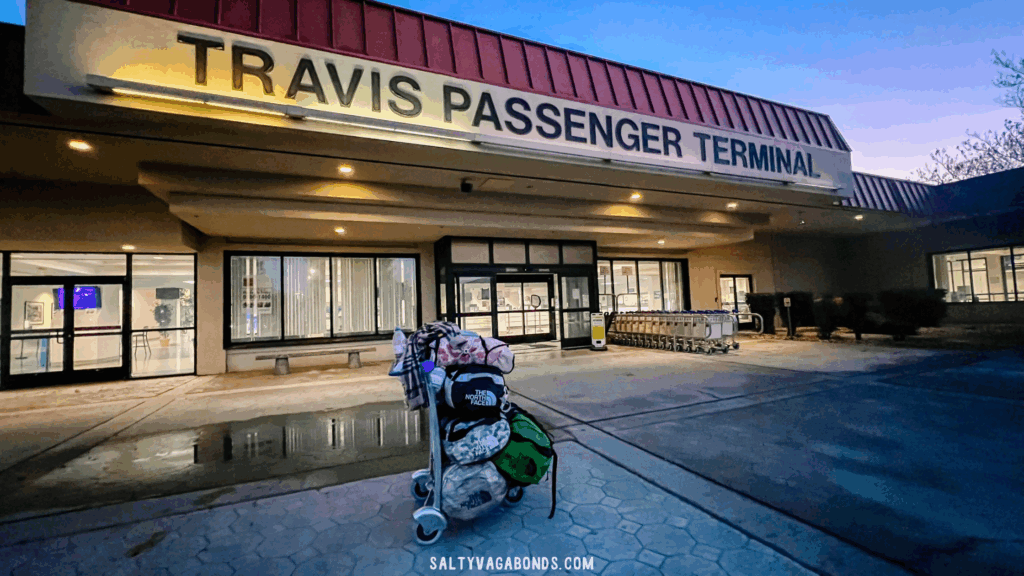
We recommend a climbing-rated carabiner, which is usually rated for 5,000+ pounds and will last forever. You can snag a solid one for around $5, and it’ll save your gear (and your back) more times than you’d think.
Ask the Flight Crew if Your Kid Can See the Flight Deck
As a kid, I always wanted to see the cockpit and I was never shy about asking. Now, as an aviator and aircraft dispatcher, I can tell you firsthand: we love giving back. One of the best parts of the job is talking with kids, letting them peek into the flight deck, and sometimes even inviting them to sit in the flight deck.
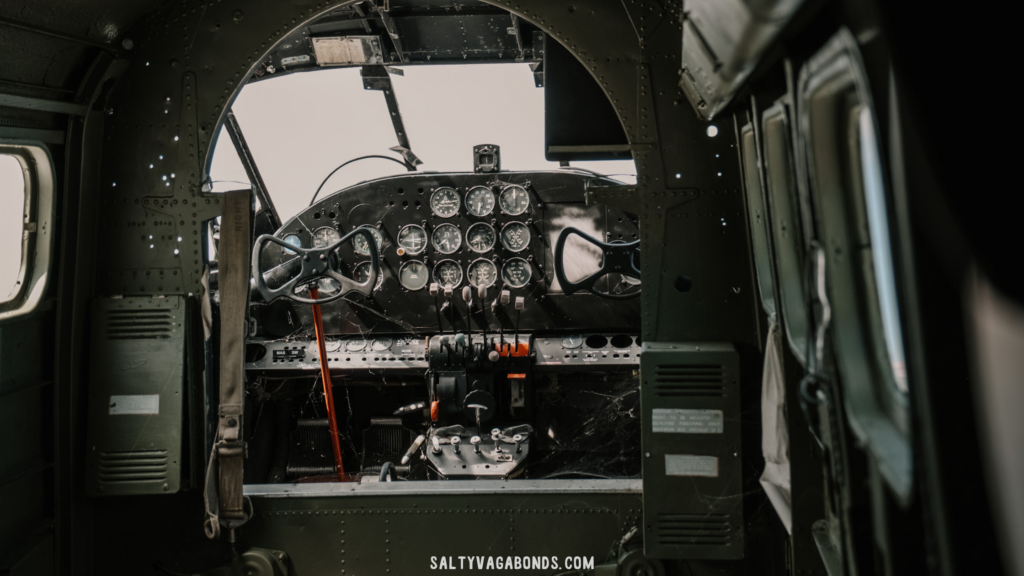
The men and women flying these missions? They remember what it felt like to be that wide-eyed kid too. So if your son or daughter is curious, just ask the flight crew. Depending on the mission and the situation, they might even let them sit in the observer seat during takeoff or landing. It’s the kind of experience they’ll talk about for years and who knows? It might just spark a future aviator in the making.
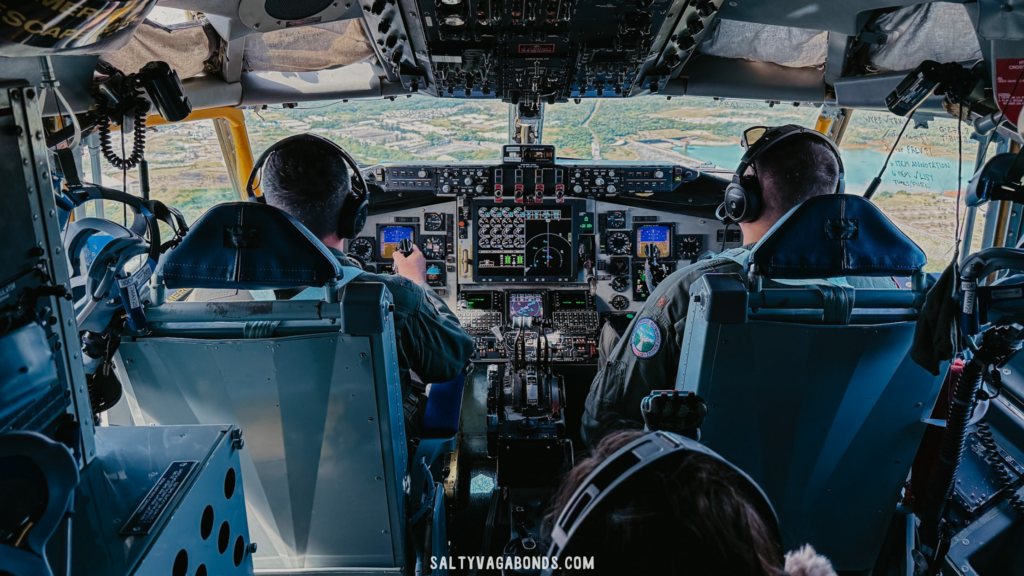
Make Friends and Watch Out for Single Parents
I’m not gonna lie, we love making new friends on our Space-A adventures. It’s one of the best parts. You get to hear travel stories, swap tips about hidden gems and good eats, and learn about new destinations from people who’ve actually been there. The girls always get excited when they meet a new friend on the plane.
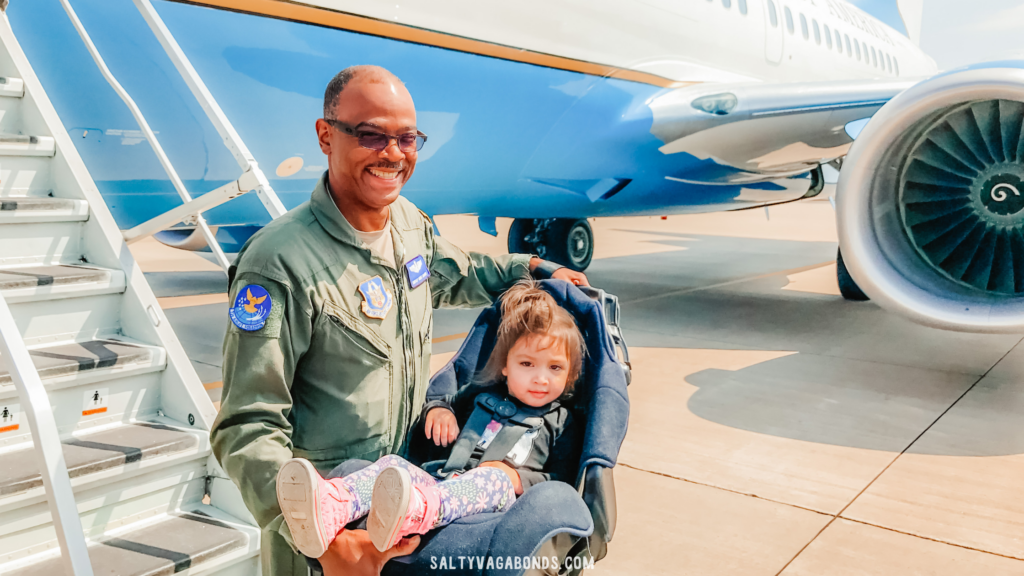
We’ve also had moments that reminded us just how much of a family the military and Space-A community really is. Once, we gave a single mom and her baby a ride to the terminal in the early morning, it made her day a little easier, and we were glad to help.
We’ve been on the receiving end too, catching rides in Guam, Ramstein, and Hawaii. If you’ve ever given us a ride, thank you, we truly appreciate it.
That sense of community? It’s real. So if you can help someone out, especially a solo parent, pass it forward. It makes this whole experience even more meaningful.
Ask Another Parent if You Need Help
If you’re traveling as a single parent, don’t be afraid to ask for help. Need someone to watch your older child or keep an eye on your luggage while you nurse or run to the bathroom? Just ask. Most of us have been there, and we get it.
Doing it all solo is totally possible, but it doesn’t have to be that hard. A little support from another parent can make the whole experience way less stressful, and honestly, a lot more enjoyable.
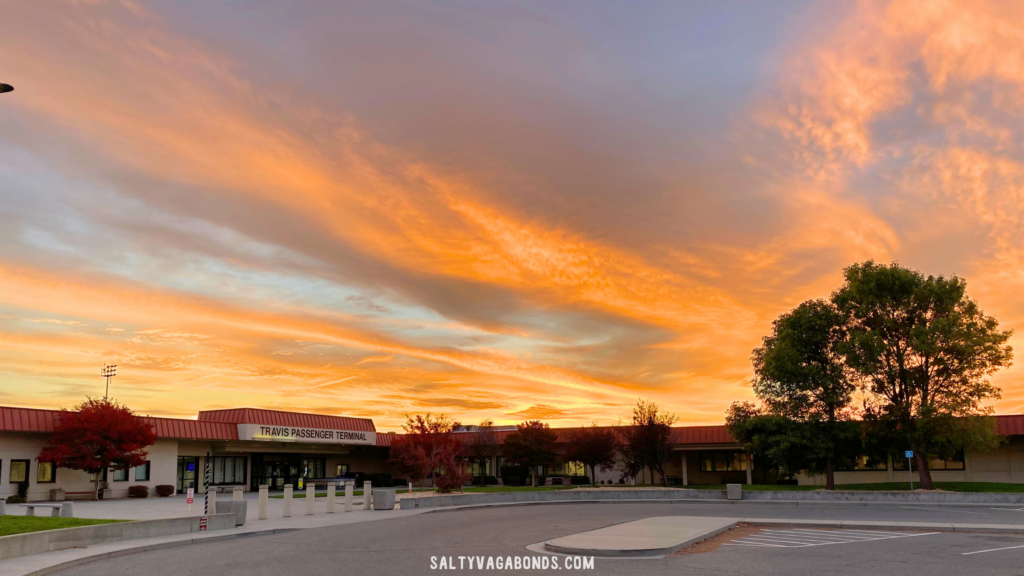
Flying Space-A with Kids Is Fun, Challenging… and Totally Worth It
We’ve been flying Space-A with our kids since 2017, and honestly, I wouldn’t do it any other way. Major airports just aren’t our thing anymore. Flying at a moment’s notice definitely comes with its challenges, but the rewards? So worth it.
We’ve been able to explore way more places than we ever imagined, all because of the savings. And along the way, we’ve met some truly kind people and made lifelong friends. If you have the time and flexibility, I say go for it. Every time we do it, we feel like we’re part of something special and we’re so grateful to be in the club.
And if you’re just getting started, you can check out our Beginner’s Guide to Flying Space-A here, and if you want to learn how to read Space-A schedules like a pro, we’ve got a full breakdown for you here.
Leave a Reply Cancel reply
Our Story
Message in a
bottle?
Join our Newsletter! We're sharing monthly tips & tricks for travel, discounts & more.
Travel Blogs
About us
Contact
Tips & Tricks
hello@saltyvagabonds.com
Link in Bio
Work With Us
SpaceA Military Flights
Santa Fe Travel Guide
Visit Disney Aulani Hawaii
Family Packing Guide
Our Photography Gear
Plan Your Travel
See you soon!
Planning
Tips
Destinations
Oceania
North America
Europe
Asia
Bali
Japan
Korea
Malaysia
singapore
Thailand
Vietnam
France
U.K.
Germany
Canada
Mexico
usa
French Polynesia
Micronesia
Hawaii
Guam
Indonesia
All Travel Blogs
Destinations
Planning
Tips
Destinations
Travel Tips
Planning
About us
Hotels
via Booking.com
Car Rental
Book a Bus/Train/Transfer
Find Cheap Flights
Get ESIM or SIM Card
Easy Currency Exchange
Book Tours & Attractions
Get Travel Insurance
via Discover Cars
via Skyscanner
via 12Go
via Wise
via Viator
via Visitors Coverage
via SimOptions